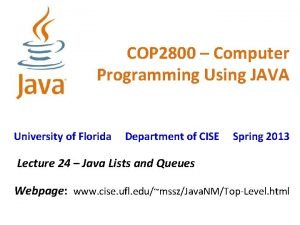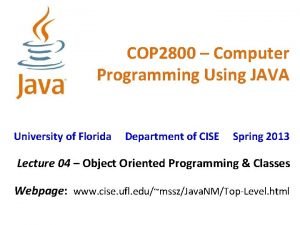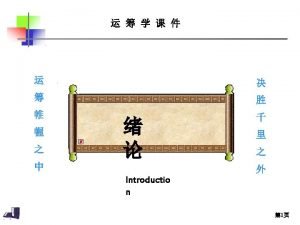COP 2800 Computer Programming Using JAVA University of









![Review: 2 -D Array Two-Dimensional Array: Array Name = “a 2” a 2[0, 2] Review: 2 -D Array Two-Dimensional Array: Array Name = “a 2” a 2[0, 2]](https://slidetodoc.com/presentation_image/8d942beeeca48ff8cf4f35d61c785689/image-10.jpg)






- Slides: 16

COP 2800 – Computer Programming Using JAVA University of Florida Department of CISE Spring 2013 Lecture 13 – Having Fun with Arrays in Java Webpage: www. cise. ufl. edu/~mssz/Java. NM/Top-Level. html

COP 2800 – Programming in JAVA • Course Objectives – Basic Knowledge of Computers & Programming – Specific Knowledge of JAVA Programming – Practical Programming Projects Build Skills • Today’s Class – What Can We Do With Arrays? – Applications of Arrays in Java • Parameterization • Ordering Integers: “Injection Sort”

Review: Java Program Structure HIGH-LEVEL VIEW PICTURE CREDIT: http: //www. webbasedprogramming. com/JAVA-Developers-Guide/ch 4. htm JAVA Units: - Packages - Classes (Instances) - Methods - Instructions - Variables

Review: Java Package Structure PICTURE CREDIT: http: //users. soe. ucsc. edu/~charlie/book/notes/summary 1 -4/sld 016. htm

What Is An Array? Arrays Are • Regular, periodic data structures • 1 -D : A vector of values (1, 4, 37, 3) • 2 -D : A matrix (like mailboxes at the Post Office) Arrays Are Used For • Storing Values for Regular Accessibility • Sorting and Searching • Regularizing Variable-Length Data

Review: 1 -D Array One-Dimensional Array: 4 13 0 1 35 2 2 19 3 a[1] = 13 Image Credit: 123 codegenerator. blogspot. com 4 Array Name = “a” 8 ARRAY ELEMENT VALUES 5 a[5] = 8 JAVA Arrays Are Zero-Indexed: 0, 1, …, N-1

Let’s Do a 1 -D Array with For Loop One-Dimensional Array: Array Name = “a” // Declare the array (1 -D, 6 elements) int a[] = new int[6] ; // Put the loop index into the array for (int i = 0, i < a. length, i++) { a[i] = 2 * i; } RESULT: a = (0, 2, 4, 6, 8, 10)

Let’s Do Sorting with a 1 -D Array What is Sorting? Sorting is an operation that orders values in a predetermined (e. g. , ascending or descending) order. SORT Ex: {3, 4, 0, 2, 1, 4} (0, 1, 2, 3, 4, 4) Set Sequence The simplest sorting algorithm is injection sort.

Injection Sorting with a 1 -D Array One-Dimensional Array: Input Array = “a” // 1: Declare the array (1 -D, 6 elements) int a[] = {3, 4, 0, 2, 1, 4}; int b[] = {0, 0, 0, 0}; // 2: Inject the values of a as loop indices for (int i = 0, i < a. length, i++) { b[a[i]]++; b = (1, 1, 2, 0) } // 3: Print sorted values (ascending order) for (int i = 0, i < b. length, i++) { if b[i] != 0 {System. out. print(i)}; }
![Review 2 D Array TwoDimensional Array Array Name a 2 a 20 2 Review: 2 -D Array Two-Dimensional Array: Array Name = “a 2” a 2[0, 2]](https://slidetodoc.com/presentation_image/8d942beeeca48ff8cf4f35d61c785689/image-10.jpg)
Review: 2 -D Array Two-Dimensional Array: Array Name = “a 2” a 2[0, 2] = 49 JAVA Arrays Are Zero. Indexed: 0, 1, …, N-1 0 27 4 49 3 1 6 8 13 77 0 1 2 3 Image Credit: 123 codegenerator. blogspot. com ARRAY ELEMENT VALUES

Let’s Do a 2 -D Array with For Loop Two-Dimensional Array: Array Name = “a 2” // Declare the array (2 -D, 2 rows x 4 cols) int Nrows = 2; int Ncols = 4; int a 2[][] = new int[Nrows][Ncols] ; // Put the sum of loop indices into array for (int i = 0, i < Nrows, i++) { for (int j = 0, j < Nrows, j++) { a 2[i][j] = i + j; } } RESULT: Row 0 of a 2 = (0, 1, 2, 3) Row 1 of a 2 = (1, 2, 3, 4)

Case 1: the “Bins” Array (Asn-2) Two-Dimensional Array: Array Name = “Bins” // Declare array (2 -D, NBins rows x 4 cols) float a 2[][] = new float[NBins][3] ; Anatomy: Dimension #1 = Bin Number (from 0 to Nbins-1) Dimension #2 = Parameters: 1 – Lower Bound of Test Interval 2 – Upper Bound of Test Interval 3 – Count of Numbers in Bin

The “Bins” Array (Asn-2), cont’d Two-Dimensional Array: Array Name = “Bins” Parameter #1 Bin Number Parameter #2 Parameter #3 Lesson Learned: Arrays can be used for storing input parameters and results.

Case 2: Tic. Tac. Toe Array (Asn-? ) Two-Dimensional Array: Array Name = “TTT” // Declare array (2 -D, 3 rows x 3 cols) char TTT[][] = new char[3][3] ; Anatomy: Dimension #1 = Row Number (from 0 to 2) Dimension #2 = Column Number (from 0 to 2) Contents of Array? char = “–” or “X” or “O”

Case 2: Tic. Tac. Toe Array (Asn-? ) Two-Dimensional Array: Array Name = “TTT” // Declare array (2 -D, 3 rows x 3 cols) char TTT[][] = new char[3][3] ; Here’s Some Pseudocode!! Initialize Array TTT with “–” To insert an X or O at location (i, j): input_char TTT[2][1] = “X”; = input_char; Array TTT - O X X O X -

This Week: Arrays and Java READING ASSIGNMENT: D. Liang: Chapters 6 & 7 By now, you should have read textbook Ch. 1 -8 Next Class (Friday 08 February) • How to Do Assignment #2 – Part III • More on Multidimensional Arrays in Java
 Cop 2800
Cop 2800 Cop 2800
Cop 2800 Cop 2800
Cop 2800 Cop 2800
Cop 2800 Cop 2800
Cop 2800 Cop 2800
Cop 2800 Good cop bad cop interrogation
Good cop bad cop interrogation Cop 1 cop 2
Cop 1 cop 2 La carga de un ascensor tiene una masa total de 2800 kg
La carga de un ascensor tiene una masa total de 2800 kg Dr 5000 spectrophotometer
Dr 5000 spectrophotometer Cs 2800
Cs 2800 Sj sqp 2800
Sj sqp 2800 6000x23
6000x23 80'in 30'u kaçtır
80'in 30'u kaçtır State and prove chebyshev's inequality theorem
State and prove chebyshev's inequality theorem Cisco aironet 1700 設定
Cisco aironet 1700 設定 Perbedaan linear programming dan integer programming
Perbedaan linear programming dan integer programming


























